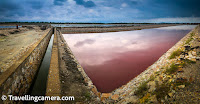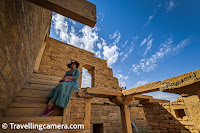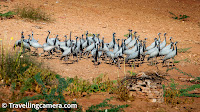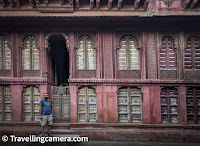Siliserh Lake is home to mugger crocodiles (Crocodylus palustris), a species native to the Indian subcontinent. These reptiles, also known as marsh crocodiles, are distinguished by their broad snouts, stocky bodies, and powerful tails. They can grow up to 12–16 feet in length and are considered one of the most adaptive crocodile species, thriving in freshwater habitats like rivers, lakes, and marshes.
Habitat and Behavior
The crocodiles at Siliserh Lake are an integral part of the lake's ecosystem. The vast water body, combined with the surrounding vegetation and rocky banks, provides an ideal environment for these reptiles to hunt, bask, and breed.
Basking on Rocky Shores:
Visitors can often spot crocodiles basking on the sunlit rocky shores of the lake. This behavior helps them regulate their body temperature, as reptiles are cold-blooded and rely on external heat sources to stay active.
Camouflaged in Water:
Crocodiles are masters of camouflage and can often be seen lurking just beneath the water's surface, with only their eyes and nostrils visible. This stealthy approach allows them to hunt efficiently.
Diet:
The crocodiles primarily feed on fish, waterfowl, and small mammals that venture close to the lake. They play a crucial role in maintaining the ecological balance by controlling the population of certain species.
Crocodile Conservation
The crocodiles at Siliserh Lake are protected under the Wildlife Protection Act of India (1972), as they are listed as a vulnerable species. Efforts are made to ensure the preservation of their habitat and to minimize human-crocodile conflicts.
Safety Tips for Visitors
While observing crocodiles at Siliserh Lake can be a thrilling experience, it's essential to prioritize safety:
Maintain Distance: Avoid venturing too close to the water's edge, especially in areas known for crocodile activity.
Follow Local Guidelines: Pay attention to warning signs and follow instructions from local guides or authorities.
Boating Caution: If you’re on a boat, avoid throwing food or objects into the water, as this may attract crocodiles.
Stay Vigilant: Crocodiles are powerful predators and can move quickly both in water and on land. Always be alert.
Best Time to Spot Crocodiles
The best time to observe crocodiles at Siliserh Lake is during the early morning or late afternoon, when they are most likely to be basking on the shores or hunting near the surface. Visiting during the winter months (October to March) enhances the experience, as the cooler weather encourages more visible activity.
The Role of Crocodiles in the Ecosystem
Crocodiles are apex predators and play a vital role in maintaining the ecological balance of Siliserh Lake. By preying on fish and other aquatic species, they prevent overpopulation, which could otherwise disrupt the lake’s ecosystem. Their presence is also an indicator of the health of the environment, as crocodiles require clean water and an abundant food supply to thrive.
A Unique Wildlife Experience
Siliserh Lake is not just a serene retreat for relaxation but also a destination for those seeking a closer connection to nature. Observing crocodiles in their natural habitat offers a glimpse into the untamed beauty of Rajasthan's wildlife. For wildlife enthusiasts, photographers, and adventure seekers, the chance to see these powerful reptiles up close is an unforgettable experience.
Other Wildlife Around Siliserh Lake
Apart from crocodiles, Siliserh Lake is a haven for birdwatchers, with species like painted storks, bar-headed geese, and Indian cormorants frequenting its waters. The area also attracts small mammals and offers occasional sightings of monkeys and jackals in the surrounding hills.
How to Visit Siliserh Lake
Location: Siliserh Lake is located approximately 13 kilometers from Alwar city.
Access: It is easily reachable by road from Alwar, and the nearest railway station is Alwar Junction.
Facilities: The Siliserh Lake Palace, now converted into a hotel, offers a great place to enjoy meals while overlooking the lake and its wildlife.
The crocodiles of Siliserh Lake add a fascinating wild edge to this picturesque destination. Whether you’re watching them bask lazily on the rocks or spotting their camouflaged forms in the water, these reptiles embody the untamed spirit of nature. For those visiting Alwar or exploring Rajasthan’s hidden gems, Siliserh Lake offers not just scenic beauty but also an opportunity to experience the thrill of encountering these ancient creatures in their natural environment.
Related Blogposts:
 Amber Fort in Rajasthan : The Pearl of Jaipur's Rajput Architecture
Amber Fort in Rajasthan : The Pearl of Jaipur's Rajput Architecture
 Chand Baori in Abhaneri: A Marvel of Ancient Indian Architecture in Rajasthan
Chand Baori in Abhaneri: A Marvel of Ancient Indian Architecture in Rajasthan
 Bhandarej Baori: An Ancient Stepwell of Rajasthan's Heritage
Bhandarej Baori: An Ancient Stepwell of Rajasthan's Heritage
.jpg) Tour de Churu Streets having grand havelis with marvelous fresco paintings | Haveli Heritage Tour Rajasthan, India
Tour de Churu Streets having grand havelis with marvelous fresco paintings | Haveli Heritage Tour Rajasthan, India
 Beautiful Vyas Chhatris in Jaisalmer, Rajasthan || the most unusual sunset point built in a cremation ground
Beautiful Vyas Chhatris in Jaisalmer, Rajasthan || the most unusual sunset point built in a cremation ground
 Magnificent Cenotaphs at the Bada Bagh, Jaisalmer, Rajasthan || Exorbitant Ticket Prices can be a deterrent to anyone visiting the place
Magnificent Cenotaphs at the Bada Bagh, Jaisalmer, Rajasthan || Exorbitant Ticket Prices can be a deterrent to anyone visiting the place
 An interesting drive from Kuldhara to Khaba Fort, Dedha, Jaisalmer, Rajasthan || The Journey was definitely worth the visit to this beautiful little fort
An interesting drive from Kuldhara to Khaba Fort, Dedha, Jaisalmer, Rajasthan || The Journey was definitely worth the visit to this beautiful little fort
 A half day detour to Sambhar Salt Lake, Rajasthan from NH48 || What makes India's Largest Inland Salt Lake worth visiting in winters?
A half day detour to Sambhar Salt Lake, Rajasthan from NH48 || What makes India's Largest Inland Salt Lake worth visiting in winters?
 A fulfilling stop at Mandore in Jodhpur, Rajasthan || The old seat of the Rathore clan and also the birthplace of Mandodari
A fulfilling stop at Mandore in Jodhpur, Rajasthan || The old seat of the Rathore clan and also the birthplace of Mandodari
 The Golden Fort of Jaisalmer, Rajasthan || A thriving, pulsating mini city within the walls of the fort
The Golden Fort of Jaisalmer, Rajasthan || A thriving, pulsating mini city within the walls of the fort
 The splendid architecture of Patwon ki Haveli in Jaisalmer, Rajasthan || One of the most opulent of the havelis in Jaisalmer
The splendid architecture of Patwon ki Haveli in Jaisalmer, Rajasthan || One of the most opulent of the havelis in Jaisalmer
 The Abandoned Village of Kuldhara near Jaisalmer, Rajasthan || Facts and Fables about why the Paliwal Brahmins abandoned this village of their ancestors
The Abandoned Village of Kuldhara near Jaisalmer, Rajasthan || Facts and Fables about why the Paliwal Brahmins abandoned this village of their ancestors
 The Amazing Pokaran Fort near Jaisalmer, Rajasthan || A beautiful structure that effortlessly blends with the desert landscape it is built in
The Amazing Pokaran Fort near Jaisalmer, Rajasthan || A beautiful structure that effortlessly blends with the desert landscape it is built in
 Vedi Temple inside KumbalGarh Fort, Rajasthan - 3 Storey Octagonal structure standing strong on 36 pillars around world's second largest wall
Vedi Temple inside KumbalGarh Fort, Rajasthan - 3 Storey Octagonal structure standing strong on 36 pillars around world's second largest wall





.jpg)
















.jpg)

.jpg)
Comments